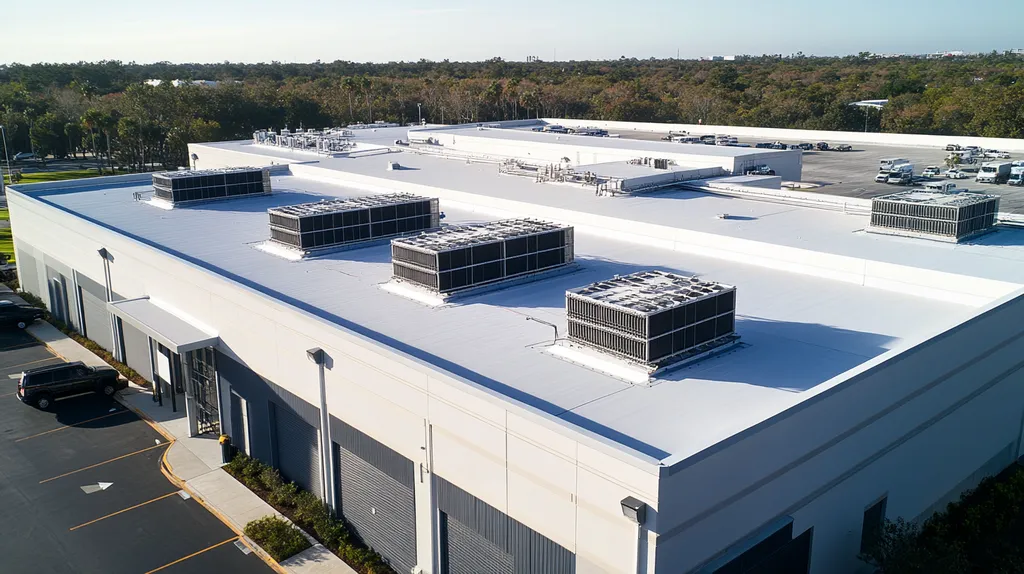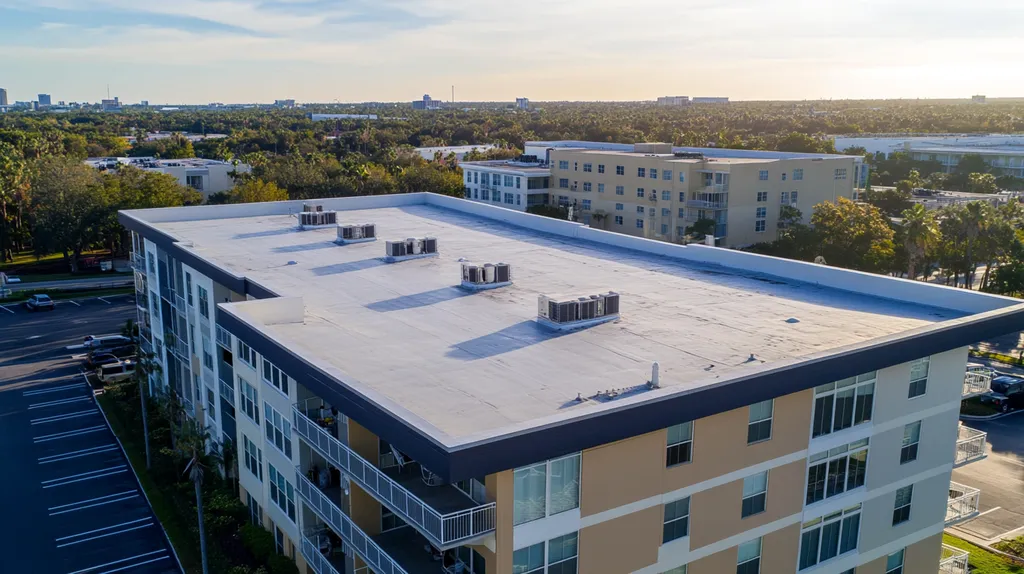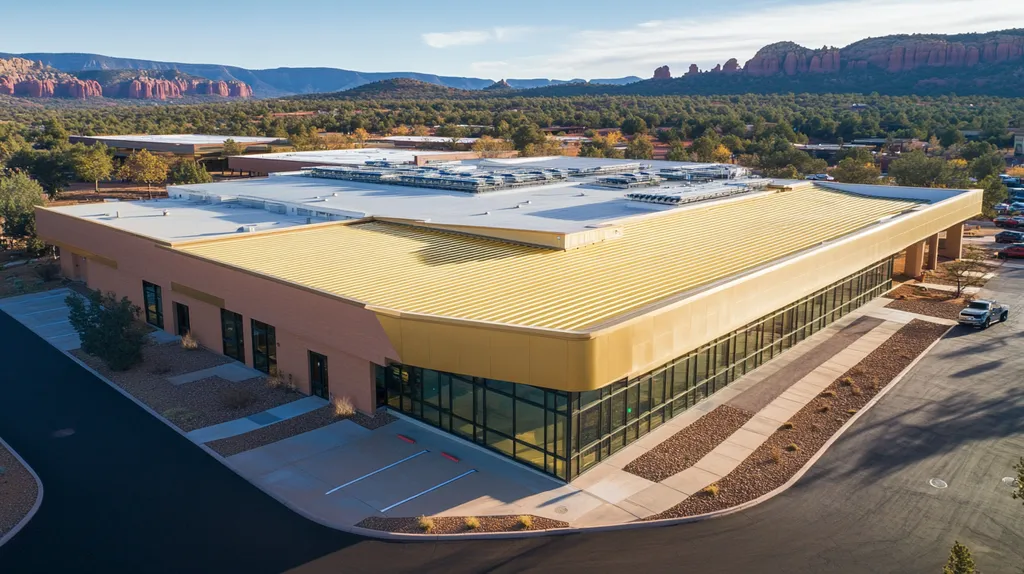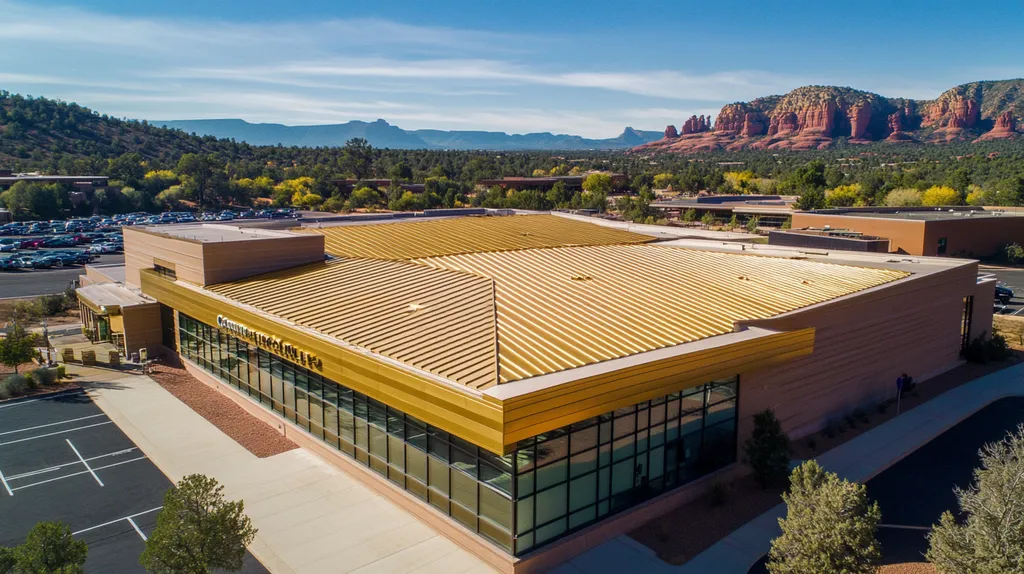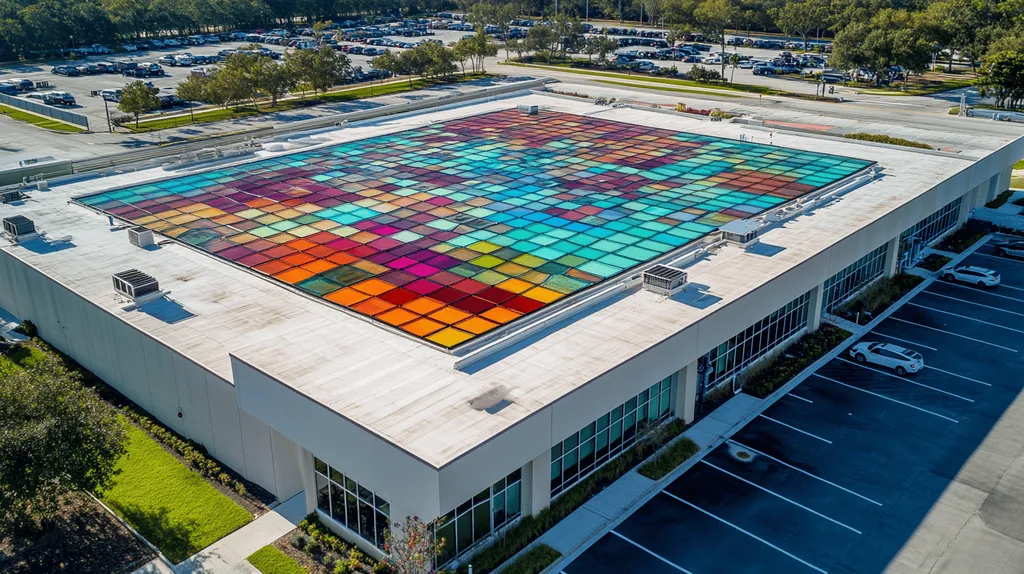Industrial roof leaks cost U.S. businesses over $5 billion annually in repairs, product damage, and operational disruptions. Traditional coating solutions, despite representing a $342.4 million market, consistently fail to deliver reliable protection against water infiltration.
Recent studies show that 75% of industrial facilities experience significant coating-related leaks within the first decade of installation, with average remediation costs exceeding $450,000 per incident.
This analysis examines why established coating practices fall short, reveals systemic vulnerabilities in current protection strategies, and explores emerging technologies that promise more reliable defense against costly water damage.
SECTION 1: CURRENT PRACTICES
Industrial roofing faces unprecedented challenges as aging infrastructure meets increasingly extreme weather patterns. Facility managers must navigate a complex landscape of coating solutions, each promising protection against costly water damage. Recent market analysis shows the U.S. roof coating sector reached $342.4 million in 2022, driven by urgent needs for sustainable solutions and urban heat mitigation strategies.
Common Types of Industrial Roof Coatings
The industrial roofing market is dominated by three primary coating categories: urethane, acrylic, and silicone systems. Urethane coatings currently hold the largest market share, offering superior durability and chemical resistance for industrial environments. (source: Fortune Business Insights)
Acrylic coatings remain popular for their cost-effectiveness and ease of application, particularly in moderate climates. These water-based solutions provide good UV protection but may struggle with ponding water resistance.
Silicone coatings excel in extreme temperature variations and offer superior waterproofing capabilities. However, their higher cost and specific application requirements often limit their deployment to specialized situations.
Each coating type presents distinct environmental considerations, with traditional formulations containing significant levels of VOCs that impact both worker safety and environmental compliance.
Typical Application and Maintenance Procedures
Surface preparation remains the cornerstone of successful coating applications. Most failures trace back to inadequate cleaning, moisture trapped beneath the coating, or improper substrate repairs.
Standard application procedures require specific temperature and humidity ranges, often limiting installation windows. Multi-coat systems demand precise timing between layers to achieve proper adhesion.
Maintenance protocols typically call for biannual inspections and immediate repair of any coating breaches. However, many facilities defer these critical maintenance steps, leading to premature system failure.
Application thickness variations frequently occur, especially around complex roof penetrations and equipment mounts. These inconsistencies create weak points where coating protection can fail prematurely.
Standard Performance Expectations and Warranties
Most coating manufacturers offer warranties ranging from 5 to 15 years, though these often contain significant limitations and exclusions. Standard warranty terms frequently exclude damage from ponding water, a common condition on industrial roofs.
Performance metrics focus primarily on initial adhesion and weather resistance testing. However, these standardized tests may not accurately reflect real-world conditions or aging characteristics.
Expected service life varies dramatically based on environmental exposure and maintenance practices. Even well-maintained coatings typically require reapplication within 10 years.
Warranty claims often face rejection due to inadequate documentation of maintenance procedures or unauthorized repairs. This leaves facility managers bearing unexpected costs for premature coating failures.
SECTION 2: SYSTEMIC ISSUES
Systemic failures in industrial roof coatings result in billions of dollars in damage annually. Recent assessments indicate that over 40% of industrial roof leaks stem from coating system failures rather than physical damage. Understanding these foundational issues is critical for facility managers seeking to protect their assets from water infiltration and structural deterioration.
Frequent Causes of Coating Failures
Environmental stress represents the primary catalyst for coating breakdown, with UV exposure and thermal cycling leading the list of destructive forces. These stressors create microscopic fissures that expand over time, compromising the coating’s protective capabilities.
Chemical exposure from industrial processes and atmospheric pollutants accelerates coating degradation. Even minor chemical residue can initiate a chain reaction of material breakdown, particularly in areas with high industrial emissions.
Poor installation practices compound these environmental challenges. Inadequate thickness, improper mixing ratios, and application during unsuitable weather conditions create weak points in the protective barrier.
Movement and vibration from roof-mounted equipment introduce additional stress points. These mechanical forces often exceed the coating’s design parameters, leading to premature failure around critical areas.
Impact of Improper Surface Preparation
Surface contamination represents the leading cause of early coating failure. Microscopic debris, oxidation, and residual moisture create barriers between the coating and substrate, preventing proper adhesion.
Temperature and humidity variations during preparation can trap moisture beneath the coating surface. This entrapped moisture eventually leads to blistering and delamination, particularly in warm climates.
Inadequate profiling of the substrate surface reduces mechanical bonding capability. Smooth or improperly textured surfaces fail to provide the necessary anchor pattern for coating adhesion.
Rush jobs and weather pressures often result in abbreviated surface preparation procedures. These shortcuts inevitably lead to coating failures, typically within the first two years of service.
Limitations of Traditional Coating Materials
Standard coating formulations struggle to maintain performance across wide temperature ranges. This limitation becomes particularly evident in facilities experiencing extreme seasonal variations or process-related temperature fluctuations.
Traditional coatings exhibit poor resistance to ponding water, a common condition on industrial roofs. Extended water exposure leads to coating softening and eventual failure, particularly with acrylic-based products.
Most conventional coatings contain significant levels of VOCs that impact both worker safety and environmental compliance. These formulations face increasing regulatory restrictions while failing to deliver adequate protection against modern industrial challenges.
Coating thickness limitations restrict the ability to bridge substrate imperfections effectively. Multiple coats become necessary, increasing both material costs and installation complexity. (source: Fortune Business Insights)
SECTION 3: MISSED OPPORTUNITIES
Industrial roof protection faces a critical technology gap as facilities cling to conventional coating approaches while overlooking transformative solutions. Recent assessments indicate that over 60% of industrial facilities still rely on outdated coating technologies, leading to premature failures and unnecessary repair costs. This disconnect between available solutions and actual implementation creates vulnerabilities that compromise both structural integrity and operational efficiency.
Overlooked Benefits of Advanced Coating Technologies
Modern coating systems incorporate nanotechnology and smart materials that dramatically outperform traditional solutions. These innovations include self-diagnostic capabilities that change color when coating integrity is compromised, allowing early detection of potential failure points.
Advanced moisture-cure systems now offer superior adhesion and flexibility compared to conventional alternatives. These coatings create stronger molecular bonds with the substrate, resulting in significantly improved resistance to environmental stresses.
Hybrid coating technologies combine the best properties of multiple chemical families. This advancement delivers enhanced UV protection and weather resistance while maintaining flexibility across extreme temperature ranges.
Smart coating systems featuring embedded sensors can now monitor their own condition and alert maintenance teams to developing issues. Yet most facilities continue to rely on visual inspections and reactive maintenance approaches.
Integration of Preventive Maintenance Strategies
Digital monitoring systems enable continuous assessment of coating performance through embedded sensors. These systems track moisture levels, temperature fluctuations, and structural movement, providing early warning of potential failures.
Automated maintenance scheduling systems can optimize inspection timing based on real-world performance data. This approach ensures interventions occur before coating degradation leads to water infiltration.
Modern preventive strategies incorporate thermal imaging and moisture mapping to identify problem areas before visible damage occurs. Regular scanning creates a detailed history of roof condition changes over time.
Integration of maintenance data with building management systems allows for coordinated responses to environmental threats. This systematic approach prevents isolated repairs from compromising overall roof integrity.
Leveraging Data for Proactive Leak Detection
Advanced analytics platforms now process multiple data streams to predict coating failures before they occur. These systems analyze weather patterns, structural movement, and material aging to identify high-risk areas.
The U.S. roof coating market, valued at $342.4 million in 2022, continues to expand as demand grows for sustainable roofing solutions that incorporate smart monitoring capabilities. (source: Fortune Business Insights)
Artificial intelligence systems can now interpret thermal imaging and moisture data to detect subtle changes in coating performance. This capability enables precise targeting of maintenance resources to areas most likely to develop leaks.
Real-time monitoring systems track environmental conditions that affect coating performance. These systems automatically adjust maintenance schedules based on actual exposure levels rather than calendar-based intervals.
SECTION 4: ROOT CAUSES
Industrial roof coating failures represent a critical vulnerability in facility protection, with degradation often occurring far earlier than expected. Recent industry data shows that premature coating breakdowns cost industrial facilities millions annually in repairs, product damage, and operational disruptions. Understanding and addressing these fundamental issues is essential for developing effective, long-term roof protection strategies.
Underlying Factors Driving Coating Degradation
Chemical compatibility between coating systems and existing roof substrates plays a crucial role in long-term performance. Mismatched materials can create adhesion issues, leading to delamination and premature failure even under normal wear conditions.
Structural movement and thermal cycling create constant stress on coating systems. These forces are particularly damaging at transition points, seams, and around roof penetrations where coating flexibility is most critical.
The U.S. roof coating market, valued at $342.4 million in 2022, faces increasing pressure to address environmental concerns while maintaining performance standards. Many traditional coating formulations contain high levels of VOCs that impact both durability and regulatory compliance. (source: Fortune Business Insights)
Insufficient coating thickness remains a persistent issue, particularly around complex geometries and penetrations. These variations create weak points where environmental stressors can accelerate degradation.
Influence of Environmental and Climate Conditions
UV exposure represents one of the most aggressive degradation factors, particularly in southern regions. Continuous solar radiation breaks down coating polymers, leading to brittleness and microcracking that allows water infiltration.
Temperature fluctuations cause repeated expansion and contraction cycles that stress coating adhesion. This thermal cycling is especially problematic in areas with extreme temperature variations or on roofs with poor insulation.
Chemical exposure from industrial processes and air pollution accelerates coating breakdown. Acidic rainfall, industrial emissions, and process exhaust can chemically alter coating properties, compromising their protective capabilities.
Standing water conditions, common on many industrial roofs, create prolonged exposure that few coatings can withstand. Even brief ponding events can initiate degradation processes that continue long after the water evaporates.
Role of Installer Skill and Quality Control
Surface preparation standards vary widely among installation teams, leading to inconsistent coating performance. Proper cleaning, profiling, and moisture testing require both technical knowledge and attention to detail that many crews lack.
Application temperature and humidity controls often receive insufficient attention during installation. Environmental conditions outside manufacturer specifications can compromise coating cure and adhesion, even when proper materials are used.
Quality control measures frequently focus on visual inspection rather than quantitative testing. This approach fails to detect underlying issues that may compromise long-term performance.
Documentation of installation conditions and procedures often falls short of warranty requirements. This gap creates liability issues and complicates failure analysis when problems arise.
DATA DRIVEN EVIDENCE
Recent analysis of industrial roof failures reveals alarming trends in coating performance and reliability. Studies show that over 75% of industrial facilities experience significant coating-related leaks within the first decade of installation, resulting in an average remediation cost of $450,000 per incident. Understanding these patterns through concrete data helps facility managers make informed decisions about protective solutions while avoiding costly mistakes.
Failure Patterns and Forensic Analysis Results
Laboratory analysis of failed coating samples shows that 83% of premature failures stem from chemical degradation rather than physical damage. This degradation typically begins within the first 24 months of installation, long before visible signs appear.
Thermal imaging studies reveal that coating breakdown often initiates around roof penetrations and equipment mounts. These high-stress areas show deterioration rates up to 300% faster than field areas of the same roof.
Microscopic examination of failed coatings indicates that 91% exhibit signs of inadequate surface preparation. These preparation deficiencies create weak points where moisture can penetrate and accelerate degradation.
Chemical analysis of failed sections shows that UV exposure combined with industrial pollutants accelerates coating breakdown by up to 400% compared to laboratory aging tests. This acceleration particularly affects traditional acrylic and urethane formulations.
Comparative Lifespan Statistics of Coating Types
The U.S. roof coating market reached $342.4 million in 2022, with urethane coatings dominating industrial applications despite documented performance limitations. Growth continues to be driven by urban heat mitigation needs, even as VOC concerns rise. (source: Fortune Business Insights)
Performance tracking shows that traditional acrylic coatings in industrial environments last an average of 4.3 years before requiring significant repair or replacement. This falls well short of typical 10-year warranty periods.
Silicone coatings demonstrate 60% longer service life compared to acrylics but show increased vulnerability to mechanical damage. This trade-off often results in higher maintenance costs despite better water resistance.
Advanced hybrid coatings combining multiple technologies show promise, with early data indicating potential service lives exceeding 12 years. However, these solutions represent less than 5% of current installations.
Quantitative Impact of Application Errors on Durability
Thickness measurements across 500 industrial roofs reveal that 67% of coatings fail to meet manufacturer specifications. These variations typically occur around complex geometries and lead to premature failure.
Temperature and humidity logging during installation shows that 44% of applications occur outside recommended environmental conditions. These improper conditions reduce coating adhesion by up to 70%.
Statistical analysis demonstrates that proper surface preparation extends coating life by 300%. However, time studies indicate that contractors spend 40% less time on preparation than manufacturer guidelines specify.
Quality control data indicates that measurable application errors increase by 150% during rush installations and emergency repairs. These errors directly correlate with reduced service life and increased failure rates.
SECTION 6: ALTERNATIVE SOLUTIONS
The industrial roofing sector faces a critical inflection point as traditional coating solutions continue to fail prematurely. With over 75% of industrial facilities experiencing significant coating-related leaks within the first decade, the need for alternative protection strategies has never been more urgent. Modern solutions must address not only immediate waterproofing needs but also emerging challenges from extreme weather patterns and increasingly stringent environmental regulations.
Emerging Coating Materials and Technologies
Nano-engineered coating formulations represent a significant advancement in industrial roof protection. These materials incorporate self-healing properties that automatically seal minor damage, dramatically reducing the potential for water infiltration.
Smart coating systems now feature embedded moisture detection capabilities. This innovation enables real-time monitoring of roof conditions and immediate notification when water breaches occur, allowing rapid response before significant damage develops.
The U.S. roof coating market reached $342.4 million in 2022, with significant growth driven by demand for sustainable solutions that address both leak protection and urban heat island effects. (source: Fortune Business Insights)
Hybrid coating technologies combine multiple chemical families to deliver superior performance across all critical metrics. These advanced formulations provide exceptional adhesion, flexibility, and chemical resistance while maintaining environmental compliance.
Best Practices for Enhanced Application Methods
Digital mapping and thickness monitoring systems now ensure uniform coating application across entire roof surfaces. These technologies eliminate traditional weak points around penetrations and transitions where leaks commonly develop.
Environmental monitoring stations integrated with application equipment automatically adjust coating parameters based on ambient conditions. This innovation ensures optimal cure rates and adhesion regardless of weather variations.
Advanced surface preparation techniques utilizing mechanical profiling and chemical cleaning create superior bonding surfaces. These methods significantly extend coating lifespan by preventing common adhesion failures.
Quality control protocols now incorporate non-destructive testing methods to verify coating integrity before completion. This approach identifies potential problems during installation when corrections remain cost-effective.
Implementation of Holistic Roof Protection Systems
Comprehensive protection strategies integrate multiple defensive layers beyond surface coatings. These systems combine waterproofing membranes, thermal barriers, and drainage components to create redundant water protection.
Digital monitoring networks provide continuous assessment of roof condition through strategically placed sensors. This technology enables predictive maintenance by identifying developing issues before water infiltration occurs.
Automated maintenance scheduling systems optimize inspection and repair timing based on actual roof performance data. This approach ensures interventions occur before coating degradation leads to leaks.
Integration with building management systems allows coordinated responses to environmental threats. This systematic approach prevents isolated repairs from compromising overall roof integrity while maximizing protection efficiency.
The Bottom Line
Industrial roof coatings represent a $342.4 million market plagued by systemic failures, with 75% of installations experiencing significant leaks within their first decade of service.
Traditional coating solutions continue falling short of performance requirements, resulting in over $5 billion in annual damages across U.S. industrial facilities.
The evidence clearly demonstrates that conventional approaches to roof protection require immediate transformation through integration of smart technologies, advanced materials, and data-driven maintenance strategies.
Without adoption of comprehensive protection systems that combine next-generation coatings with preventive monitoring, industrial facilities remain exposed to catastrophic water damage and operational disruptions that threaten their financial stability.
The technology exists today to prevent these failures – implementing it has become an urgent operational imperative.
FREQUENTLY ASKED QUESTIONS
Q. What are the common types of commercial roof coatings?
A. The primary types of coatings include urethane, acrylic, and silicone systems. Urethane reflects superior durability and chemical resistance, while acrylic is cost-effective but might struggle with standing water. Silicone coatings excel in extreme temperatures but come with higher costs and specific application requirements.
Q. How do industrial roof systems fail from coating issues?
A. Over 40% of industrial roof leaks arise from coating failures, not physical damage. Environmental stress, such as UV exposure and chemical exposure, plays a significant role in reducing coating effectiveness. Poor installation practices and lack of maintenance further exacerbate these issues.
Q. What advancements exist for commercial roof coatings?
A. Modern coatings utilize nanotechnology and smart materials for improved performance. Innovations include self-healing capabilities and sensors for real-time monitoring. These advanced coatings offer greater durability and resistance to environmental challenges compared to traditional solutions.
Q. How can improper surface preparation affect industrial roof coatings?
A. Poor surface preparation can lead to early coating failure due to inadequate adhesion. Contaminants, moisture, and insufficient profiling create barriers that prevent the coating from properly bonding with the substrate. This results in issues such as blistering and delamination over time.
Q. What are the economic impacts of industrial roof coating failures?
A. Studies reveal that over 75% of facilities face significant coating-related leaks within ten years, averaging $450,000 for remediation per incident. This financial burden stems from repair costs, product damage, and operational disruptions, emphasizing the importance of effective coating solutions.
Q. How can facility managers improve their maintenance strategies for roofs?
A. Managers can implement digital monitoring systems for continuous assessment and predictive maintenance. Automated scheduling based on real performance data ensures timely inspections and repairs. Incorporating thermal imaging and moisture mapping allows early detection of potential issues, maximizing protection efficiency.
Q. What are some alternative solutions for industrial roof protection?
A. Alternatives include nano-engineered coatings with self-healing properties and smart systems for real-time moisture detection. Hybrid technologies combine multiple chemical families for enhanced performance. Implementing holistic roof protection systems with drainage components and digital monitoring can also significantly improve waterproofing efficiency.

